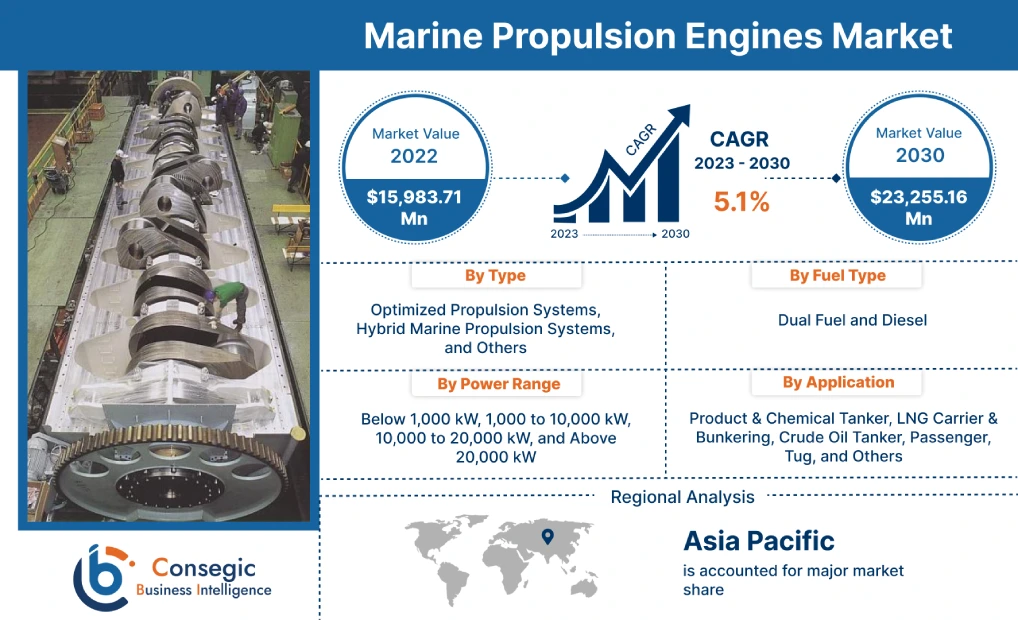Marine Propulsion System Market Size :
The Marine Propulsion Engines Market size was valued at USD 15,983.71 Million in 2022, registering a CAGR of 5.1% during the forecast period (2023-2030), and the market is projected to be worth USD 23,255.16 Million by 2030.
Marine Propulsion System Market Scope & Overview:
Marine Propulsion System is referred as technology used to generate thrust to propel marine crafts on water. The marine propulsion system is used to transport goods including natural resources, consumer supplies, and others from one port to another. The system follows Newton's Third law of motion. The propulsion devices apply force on the surrounding water to develop reaction force on the craft to push the craft ships in desired direction. As per the analysis, the marine propulsion systems are categorized into various types including optimized propulsion systems, hybrid marine propulsion systems, nuclear propulsion systems, wind propulsion systems, solar propulsion, gas turbine propulsion systems, and others. Additionally, marine propulsion engines are used for multiple applications including fishing, offshore, crude oil tanker, product & chemical tanker, LNG carrier & bunkering, tug, and others. Also, marine propulsion engines are used by the military industry.
Marine Propulsion System Market Insights :
Marine Propulsion System Market Dynamics - (DRO) :
Key Drivers :
Increasing demand of high-performance engines and increasing investments in marine propulsion system
The rising demand of high-performance engines and faster propulsion systems for marine transportation is driving the growth of the market. Moreover, increasing investments in marine propulsion systems are propelling the growth of market. For instance, in October 2021, Maersk invested in Vertoro to develop green lignin marine fuels. Based on the analysis, the green lignin marine fuel has an applications for decarbonization of marine operations. Therefore, increasing investments in propulsion systems is boosting the growth of market.
Growing improvements in propulsion system is driving the market
The growing improvements in propulsion system for marine transportation are propelling the growth of the market. For instance, in June 2019, ABB expanded the power range of Azipod propulsion system to improve the operational efficiency. The advanced Azipod propulsion system covers the power range of 1-22MW. Additionally, the advanced propulsion system reduces fuel consumption by 20% as compared to the traditional shaft line propulsion system. Therefore, increasing advancements in propulsion systems are promoting the growth of market.
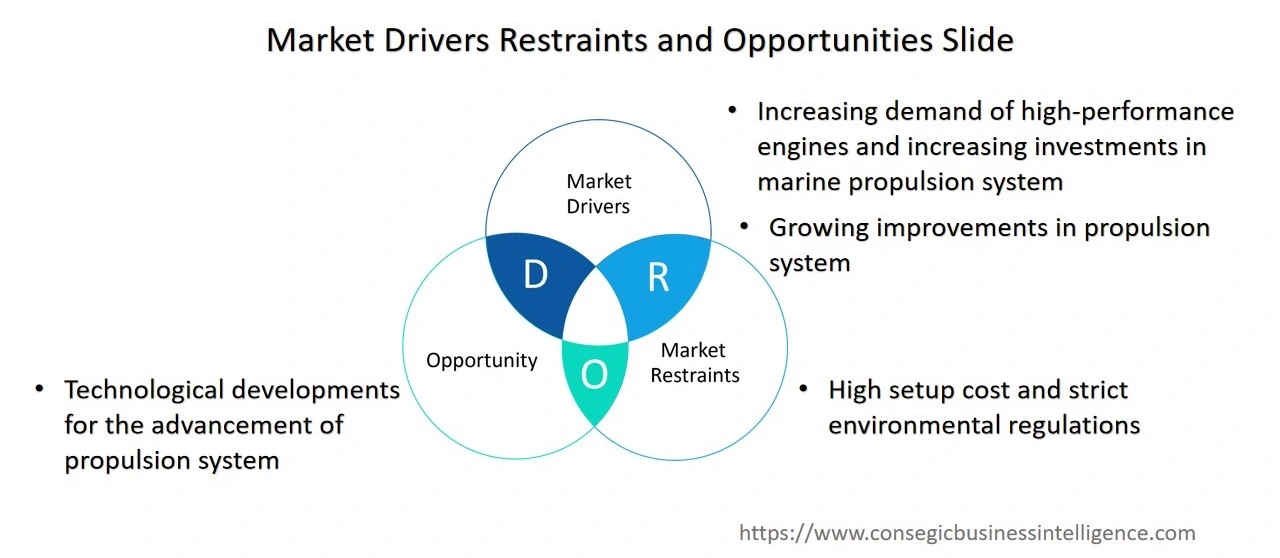
Key Restraints :
High setup cost and strict environmental regulations
The high capital investments required to set up industrial manufacturing facilities are hampering the growth of market. Additionally, based on the analysis, strict environmental regulations for marine environment are hindering the growth of market. For instance, according to U.S. government and International Maritime Organization, the fuel sulfur concentrations should be below 0.10 weight percent and the engines with power range above 130 kW should be certified, to meet required emission standards.
Future Opportunities :
Technological developments for the advancement of propulsion system
The technological developments for the advancement of propulsion systems will strengthen the marine propulsion engines market opportunities and trends. For instance, in August 2022, ABB developed advanced icebreaker propulsion systems comprises of steam engines connected to the propeller with advances in electric equipment technology. Therefore, as per the analysis, development of advanced technologies for the improvement of propulsion systems will create opportunities in the marine propulsion engines market trends.
Marine Propulsion System Market Report Insights :
| Report Attributes | Report Details |
| Study Timeline | 2017-2030 |
| Market Size in 2030 (USD Billion) | 23,255.16 Million |
| CAGR (2023-2030) | 5.1% |
| Base Year | 2022 |
| By Type | Optimized Propulsion Systems, Hybrid Marine Propulsion Systems, and Others |
| By Fuel Type | Dual Fuel and Diesel |
| By Power Range | Below 1,000 kW, 1,000 to 10,000 kW, 10,000 to 20,000 kW, and Above 20,000 kW |
| By Application | Product & Chemical Tanker, LNG Carrier & Bunkering, Crude Oil Tanker, Passenger, Tug, and Others |
| By Geography | Asia-Pacific, Europe, North America, South America, Middle East & Africa |
| Key Players | ABB, Caterpillar, Cummins Inc., Daihatsu Diesel Mfg. Co. Ltd., Fiarbanks Morse Engine, Hercules Electric Marine, Hyundai Heavy Industries Co. Ltd, Man Se (Man Diesel & Turbo), Masoon Marine, Mitsubishi Heavy Industries Ltd., Nigata Power Systems Co. Ltd., Rolls-Royce Plc, Scania, Yanmar Co. Ltd. |
| Geographies Covered | |
| North America | U.S. Canada Mexico |
| Europe | U.K. Germany France Spain Italy Russia Benelux Rest of Europe |
| APAC | China South Korea Japan India Australia ASEAN Rest of Asia-Pacific |
| Middle East and Africa | GCC Turkey South Africa Rest of MEA |
| LATAM | Brazil Argentina Chile Rest of LATAM |
| Report Coverage | Revenue Forecast, Competitive Landscape, Growth Factors, Restraint or Challenges, Opportunities, Environment & Regulatory Landscape, PESTLE Analysis, PORTER Analysis, Key Technology Landscape, Value Chain Analysis, Cost Analysis, and Regional Trends & Forecast |
Marine Propulsion System Market Segmental Analysis :
By Type :
The type segment is divided into Optimized Propulsion Systems, Hybrid Marine Propulsion Systems, and Others
Hybrid marine propulsion systems accounted for the major market share in the year 2022 for market due to rising adoption of hybrid marine propulsion engines. The hybrid marine propulsion engines have flexible operation profiles with reduced emission property. Based on the analysis, the hybrid engines combine both combustion engines with battery power to optimize the efficiency and reduce emission. For instance, MAN Energy Solutions offers hybrid propulsion systems comprises of high and medium speed engines, injection systems, electric power, and others. The system is featured with zero emission, optimum efficiency, and extra flexibility. Therefore, increasing adoption of hybrid engines is propelling the development of hybrid marine propulsion systems segment in market.
The optimized propulsion system is expected to grow during the forecast period owing to increasing requirement for the optimized system due to the excellent features. The optimized propulsion system offers features including examination of operational profile and components of the ships. For instance, Alphatronic 3000 propulsion control system is used to optimize engine operations and propeller functions. Thus, increasing requirement for optimized propulsion systems due to optimization features offered, is promoting the developemnt of optimized propulsion systems segment trends in the market.
By Fuel Type :
The fuel type is categorized into Dual Fuel and Diesel.
Diesel segment holds largest market share in the year 2022 for market due to easy availability and cost effectiveness. Also, diesel engines require less maintenance and are more reliable. The commercial ships are equipped with diesel engines. Moreover, the trend of transport and energy system with modern ro-ro cargo liners is propelling the requirement of diesel engines in market. Thus, the increasing utilization and easy availability of diesel fuel are propelling the developemnt of diesel segment in market.
The dual fuel segment is projected to grow during the forecast period due to the property to comply with environmental regulations with both fuels including diesel and gas fuel. For instance, Yanmar has developed dual fuel engine with both fuels including diesel and gas fuel. The engine complies with emission control of SOx, NOx, IMO, and others. Thus, the property of dual engines to comply environmental regulations is boosting the trends of dual fuel segment in marine propulsion engines market.
By Power Range :
The power range segment is bifurcated into Below 1,000 kW, 1,000 to 10,000 kW, 10,000 to 20,000 kW, Above 20,000 kW.
Above 20,000 kW power range segment accounted for largest market share in marine propulsion engines market for the year 2022, due to increasing requirement for high power and high-performance engines for increased load capacity of the vessel. Additionally, as per the analysis, engines with power range of above 20,000 kW are used for transportation of natural resources and other material for longer distance. Therefore, the rising need of high-power engines for increased load capacity is driving the expansion of above 20,000 kW power range segment in marine propulsion engines market growth.
10,000 to 20,000 kW power range segment is expected to grow during the forecast period owing to increasing adoption of 10,000 to 20,000 kW power range for container ships and naval ships. The engines with a power range of 10,000 to 20,000 kW are used for shorter distances. Thus, the increasing adoption of power range 10,000 to 20,000 kW for shorter distances is propelling the development of engines with power range of 10,000 to 20,000 kW in marine propulsion engines market.
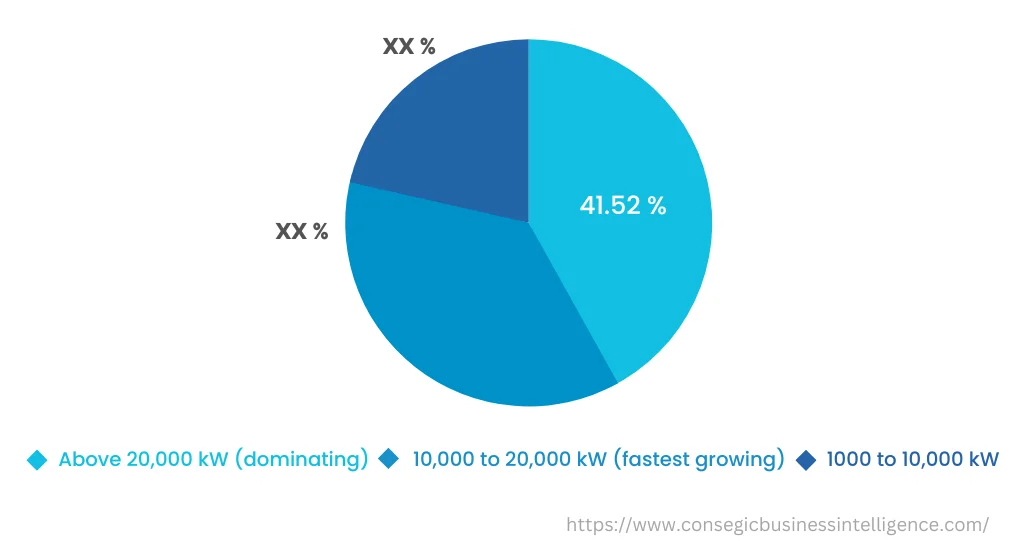
By Application :
The application segment is classified into Product & Chemical Tanker, LNG Carrier & Bunkering, Crude Oil Tanker, Passenger, Tug, and Others.
Crude oil tanker segment holds major market share in year 2022 for marine propulsion engines market due to increasing marine propulsion engines market demand for increased transportation of crude oil. Marine propulsion systems are used to reduce emissions to comply the environmental regulations. Thus, the rising adoption of marine propulsion systems for crude oil transportation is driving the expansion of crude oil tanker segment in marine propulsion engines market.
LNG carriers and bunkering segment is projected to grow during the forecast period due to increasing demand for marine propulsion systems with high power and high performance. For instance, Hyundai Heavy Industries offered RT-flex Engines designed for bulk carrier ships and tankers. The engine is compliant with IMO Tier 3 NOx emission level, equipped with SCR catalyst. Therefore, increasing use of propulsion systems to reduce emission and rising demand of high-performance engines for carrier transportation is promoting the expansion of LNG carriers and bunkering segment in marine propulsion engines market.
By Region :
The regional segment includes North America, Europe, Asia Pacific, Middle East and Africa, and Latin America.
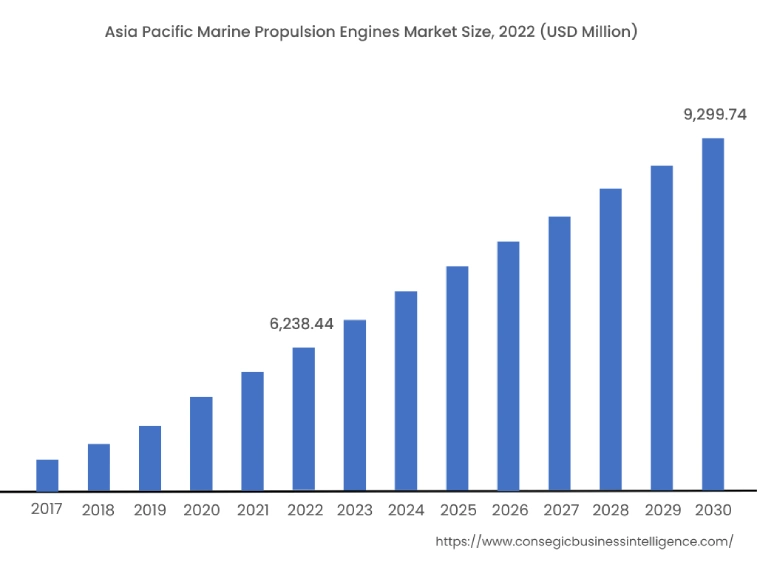
Asia Pacific region is accounted for the marine propulsion engines market share valued at USD 6,238.44 million in the year 2022 and is expected to grow at CAGR of 5.4% during the forecast period. Based on the global marine propulsion engines market analysis, the increasing maritime trade activities and rising developments in import and export facilities are driving the marine propulsion engines market trends in the region. Additionally, China holds 29.9% of market share in marine propulsion engines market followed by Japan, India, and others. The Asia pacific region dominates in maritime trade resulting to rise the marine propulsion engines market growth. For instance, According to United Nations Conference on Trade and Development (UNCTAD), in 2020, the developing countries of Asia Pacific region accounted for 76% of all maritime trade. Additionally, in 2019, Oceania including Australia, New Zealand, and SIDS in the Pacific holds 14% of world maritime export and 1% of world maritime import. Therefore, the increasing maritime trade activities are promoting the trends of marine propulsion engines market in Asia Pacific region.
North America is expected to grow during the forecast period with CAGR of4.6% owing to expansion of seaborne trade. Additionally, increasing demand of light weight, high-value, heavy cargo ships for import and export activities is propelling the marine propulsion engines market trends in North America region. For instance, according to U.S. Department of Transportation, in 2020, seaborne shipping accounted more value (more than USD 1.5 trillion) and tonnage (1.5 million short tons) in U.S. trade. Moreover, U.S. port increased the requirement of shipping vessels by 10%. Thus, the expansion of seaborne trade and rising demand for shipping components are driving marine propulsion engines market trends in North America region.
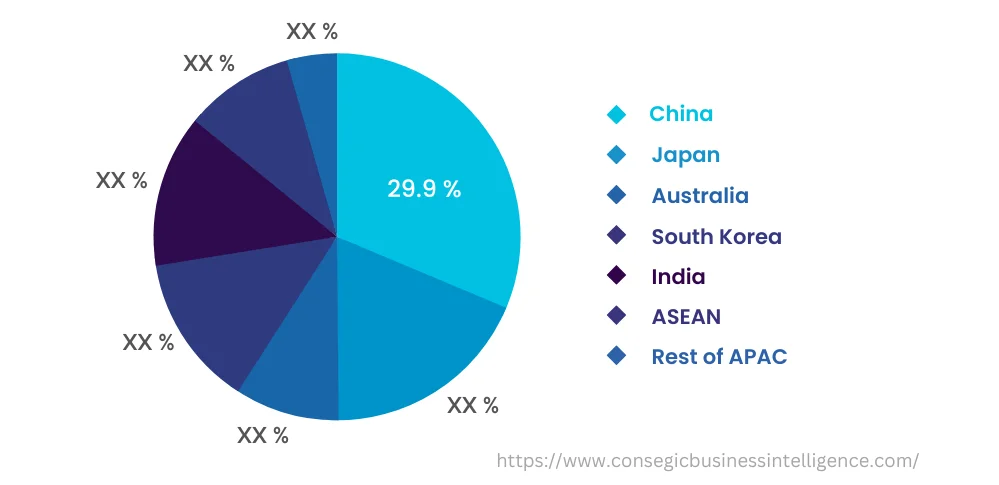
Top Key Players & Market Share Insights:
The competitive landscape of the market has been analyzed in the report, along with the detailed profiles of the major players operating in the industry. Further, the surge in Research and Development (R&D), product innovation, various business strategies, and application launches have accelerated the development of the Global Marine Propulsion Engines Market. Key players in the marine propulsion engines industry include-
- Caterpillar
- Cummins Inc.
- Daihatsu Diesel Mfg. Co. Ltd.
- Fiarbanks Morse Engine
- Hercules Electric Marine
- Masoon Marine
- Hyundai Heavy Industries Co. Ltd
- Man Se (Man Diesel & Turbo)
- Mitsubishi Heavy Industries Ltd.
- Nigata Power Systems Co. Ltd.
- Rolls-Royce Plc
- Scania
- Yanmar Co. Ltd.
Recent Industry Developments :
- In October 2022, Hercules Electric Marine collaborated with Hillcrest Energy Technologies. The collaboration aims to integrate the high efficiency transaction inverter with electric propulsion system resulting in optimizing electric mobility products.
Key Questions Answered in the Report
What are Marine propulsion Engines? +
Marine Propulsion System is referred as technology used to generate thrust to propel marine crafts on water. The propulsion devices, including engines, propellers, and others, apply force on the surrounding water to develop reaction force on the craft to push the craft ships in desired direction. The marine propulsion system is used to transport goods including natural resources, consumer supplies, and others from one port to another.
Competitive analysis on key market players gaining market shares? +
The competitive analysis of the market has been analyzed in the report, along with the detailed profiles of the major players operating in the industry. The competitive analysis is based on Business Overview, Business Financials (USD Million), Product Category, Type, and Specification, Main Business/Business Overview, Geographical Analysis, Recent Development, and Swot Analysis of the key market players.
SWOT analysis of key market players operating in the region? +
The SWOT analysis of the key market players has been analyzed on the basis of parameters including Strengths, Weaknesses, Opportunities, and Threats of the major market players.
PESTLE analysis of Marine Propulsion Engines market report. +
The PESTLE analysis of Marine Propulsion Engine Market comprises of Political Factors, Economic Factor, Social Factors, Technological Factor, Environmental Factors, and Legal Factor. For instance, environmental factors including strict environmental regulations associated with the marine environment.
What specific segmentation details are covered in Marine Propulsion Engine market report, and how do each dominating segment is influencing the demand globally? +
As aforementioned, each dominating segment is influencing the demand globally due to growing demand of propulsion system. Moreover, increasing adoption of propulsion system for maritime is accounted for driving the marine propulsion engines market.
